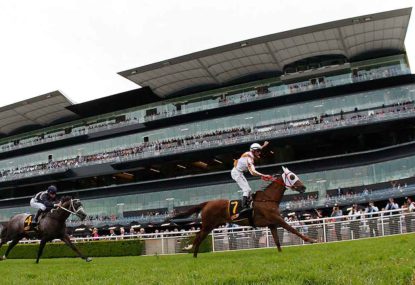TWO GOOD! Zahra wins back-to-back Melbourne Cups on Without a Fight as three horses pull up lame
Without a Fight completed the rare Caulfield Cup-Melbourne Cup double on Tuesday as star jockey Mark Zahra went back-to-back in the big one after…

“How did that win?” is often the question asked by my punting mates or the crusty ‘Old Salty’ down at the pub or TAB.
“Have another look at your form guide,” is often my response.
I’m not a punting freak by any means, I’m not one who backs double-figure priced winners on a regular basis. But it’s not exactly a rarity the number of times a horse is bagged unmercifully by so called ‘experts’ as only having won due to track bias when in fact, it had the form to win.
I’ll say from the outset that I think track bias is a myth.
A majority of the time when there is a perceived bias, it is in fact speed bias and not the highly popular and convenient track bias.
The most laughable aspect is that track bias always seems to rear its head according to analysts and commentators when horses aren’t in the market win. Had they been in the market, no such comments would be made or such questions asked.
I’m always amused to hear experts speak of track bias, even sometimes before the meeting has started – speculating as to what the bias will be for the day ahead.
When I talk about a horse having the form to win, I speak of horses who have finished within three to four lengths of the winner in the same grade of race at one of their last few runs. Generally, it proves the horse is good enough to race in that particular grade and often the beaten margin it has been beaten previously can be turned around, given better luck in running or a more suitable pace.
When I speak of pace bias, I refer to when they go out in front quicker than you can say ‘Jack Robinson’, often a swooper can get home and when they dawdle in front, the leaders are hard to run down. This is nothing to do with track bias, but everything to do with the pace of the race.
Also, in general, horses racing in the first three or four win the majority of races time and time again – this is a proven fact and therefore nothing to do with track bias.
In other conditions, such as bog tracks, or when the rail is in differing positions, it can favour either those on the speed or those coming from the back. It’s only in these conditions which I will consider the concept of track bias – and even then, pace is still usually the best guide when analysing the result.
In the punting game we’re often defeated by paralysis by analysis but in my humble opinion time would be better spent trying to work out what the pace will be like in any given race and where in the run your selection is likely to be positioned, which will then give you a far better understanding than trying to work out any perceived bias.